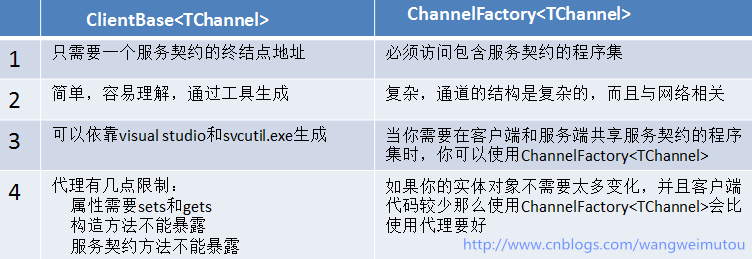创建WCF 服务客户端应用程序需要执行下列步骤:
- 获取服务终结点的服务协定、绑定以及地址信息
- 使用该信息创建 WCF 客户端
- 调用操作
- 关闭该 WCF 客户端对象
WCF客户端调用服务存在以下特点:
- 服务和客户端使用托管属性、接口和方法对协定进行建模。 若要连接客户端应用程序中的服务,则需要获取该服务协定的类型信息。通常,我们使用Svcutil.exe(ServiceModel Metadata Utility Tool)来完成,也可以直接在客户端项目上引用服务地址完成。它们会从服务中下载元数据,并使用您选择的语言将其转换到托管源代码文件中,同时还创建一个您可用于配置 WCF 客户端对象的客户端应用程序配置文件
- WCF 客户端是表示某一个WCF服务的一个本地对象,客户端可以使用这种形式与远程服务进行通信。 WCF 客户端类型可以实现目标服务协定,因此当您创建一个服务协定,并对其进行配置后,就可以直接使用客户端对象调用服务操作。 WCF 运行时将方法调用转换为消息,然后将这些消息发送到服务,侦听回复,并将这些值作为返回值或 out 参数(或 ref 参数)返回到 WCF 客户端对象中。
- 创建并配置了客户端对象后,请创建一个 try/catch 块,如果该对象是本地对象,则以相同的方式调用操作,然后关闭 WCF 客户端对象。 当客户端应用程序调用第一个操作时,WCF 将自动打开基础通道,并在回收对象时关闭基础通道。 (或者,还可以在调用其他操作之前或之后显式打开和关闭该通道。)
- 不应该使用 using 块来调用WCF服务方法。因为C# 的“using”语句会导致调用 Dispose()。 它等效于 Close(),当发生网络错误时可能会引发异常。 由于对 Dispose() 的调用是在“using”块的右大括号处隐式发生的,因此导致异常的根源往往会被编写代码和阅读代码的人所忽略。 这是应用程序错误的潜在根源。
WCF客户端调用服务方式:
- WCF通信机制由它自身复杂的体系结构所决定,但WCF服务给我们提供了两种不同的机制来创建客户端程序调用,一种是ClientBase<TChannel>类,另一种是ChannelFactory<TChannel> 类。
- ClientBase<TChannel>:创建客户端代理类的基类,客户端代理类通过继承该基类,调用WCF的内部通信机制来实现WCF客户端与服务端的通信。代理类是一个公开单个CLR接口来表示服务契约的CLR类,代理类和服务契约很相似,但是他有着附加的方法来管理代理的生命周期和连接服务。通过visual studio 右键添加服务引用和通过svcutil.exe命令行工具生成的客户端都属于这种方式。(如果不熟悉svcutil.exe,请参照WCF初探-1:认识WCF)
- ChannelFactory<TChannel>:使用通道工厂类取决于你是否拥有描述服务契约的本地接口。最大的好处是你可以已扩展的方式更容易的修改通道的通信机制,如果你需要共享服务和客户端之间的契约组件,那么使用ChannelFactory<TChannel>可以更有效的节省时间,但客户端必须完成对服务契约组件的引用。
- ClientBase<TChannel>和ChannelFactory<TChannel>的差异:

WCF客户端调用服务示例:
- 解决方案如下图所示:

- 工程结构说明:
Service:类库程序,定义服务契约和实现,里面包含User数据契约和GetInfo()获取用户信息的服务契约方法。
IUserInfo.cs的代码如下:

using System.ServiceModel; using System.Collections.Generic; using System.Runtime.Serialization; namespace Service { [ServiceContract] public interface IUserInfo { [OperationContract] User[] GetInfo(int? id=null); } [DataContract] public class User { [DataMember] public int ID { get; set; } [DataMember] public string Name { get; set; } [DataMember] public int Age { get; set; } [DataMember] public string Nationality { get; set; } } }
UserInfo.cs的代码如下:

using System; using System.Collections.Generic; using System.Linq; using System.Text; namespace Service { public class UserInfo:IUserInfo { public User[] GetInfo(int? id=null) { List<User> Users = new List<User>(); Users.Add(new User { ID = 1, Name = "JACK", Age = 20, Nationality = "CHINA" }); Users.Add(new User { ID = 2, Name = "TOM", Age = 18, Nationality = "JAPAN" }); Users.Add(new User { ID = 3, Name = "SMITH", Age = 22, Nationality = "KOREA" }); Users.Add(new User { ID = 4, Name = "ALENCE", Age = 21, Nationality = "INDIA" }); Users.Add(new User { ID = 5, Name = "JOHN", Age = 22, Nationality = "SINGAPORE" }); if (id != null) { return Users.Where(x => x.ID == id).ToArray(); } else { return Users.ToArray(); } } } }
Host:控制台应用程序,添加对Service程序集的引用,寄宿服务程序。
Program.cs代码如下

using System; using System.Collections.Generic; using System.Linq; using System.Text; using Service; using System.ServiceModel; namespace Host { class Program { static void Main(string[] args) { using (ServiceHost host = new ServiceHost(typeof(UserInfo))) { host.Opened += delegate { Console.WriteLine("服务已经启动,按任意键终止!"); }; host.Open(); Console.Read(); } } } }
App.config代码如下:

<?xml version="1.0"?> <configuration> <system.serviceModel> <services> <service name="Service.UserInfo" behaviorConfiguration="mexBehavior"> <host> <baseAddresses> <add baseAddress="http://localhost:1234/UserInfo/"/> </baseAddresses> </host> <endpoint address="" binding="wsHttpBinding" contract="Service.IUserInfo" /> <endpoint address="mex" binding="mexHttpBinding" contract="IMetadataExchange"/> </service> </services> <behaviors> <serviceBehaviors> <behavior name="mexBehavior"> <serviceMetadata httpGetEnabled="true"/> <serviceDebug includeExceptionDetailInFaults="true"/> </behavior> </serviceBehaviors> </behaviors> </system.serviceModel> </configuration>
Client1:控制台应用程序,添加对服务终结点地址http://localhost:1234/UserInfo/的引用,设置服务命名空间为UserInfoServiceRef,生成客户端代理类和配置文件代码后,完成Client1对服务的调用。
Program.cs的代码如下:

using System; using System.Collections.Generic; using System.Linq; using System.Text; using Client1.UserInfoServiceRef; namespace Client1 { class Program { static void Main(string[] args) { UserInfoClient proxy = new UserInfoClient(); User[] Users = proxy.GetInfo(null); Console.WriteLine("{0,-10}{1,-10}{2,-10}{3,-10}","ID","Name","Age","Nationality"); for(int i=0;i<Users.Length;i++) { Console.WriteLine("{0,-10}{1,-10}{2,-10}{3,-10}", Users[i].ID.ToString(), Users[i].Name.ToString(), Users[i].Age.ToString(), Users[i].Nationality.ToString()); } Console.Read(); } } }
Client2:控制台应用程序,使用svcutil.exe工具生成客户端代理类,在命令行中输入以下命令:
1.在运行中输入cmd打开命令行,输入 cd C:Program Files (x86)Microsoft SDKsWindowsv7.0ABin
2.输入svcutil.exe /out:f: UserInfoClient.cs /config:f:App.config http://localhost:1234/UserInfo/ (注意:端口号改成本机服务寄宿的端口号)
3.将生成的App.config和UserInfoClient.cs复制到Client2的工程目录下,完成Program.cs代码,代码和Client1的代码一样。
Client3:控制台应用程序,添加对Service程序集的引用,完成Program.cs代码,代码如下:

using System; using System.Collections.Generic; using System.Linq; using System.Text; using Service; using System.ServiceModel; using System.ServiceModel.Channels; namespace Client3 { class Program { static void Main(string[] args) { EndpointAddress address = new EndpointAddress("http://localhost:1234/UserInfo"); WSHttpBinding binding = new WSHttpBinding(); ChannelFactory<IUserInfo> factory = new ChannelFactory<IUserInfo>(binding,address); IUserInfo channel = factory.CreateChannel(); User[] Users = channel.GetInfo(null); Console.WriteLine("{0,-10}{1,-10}{2,-10}{3,-10}", "ID", "Name", "Age", "Nationality"); for (int i = 0; i < Users.Length; i++) { Console.WriteLine("{0,-10}{1,-10}{2,-10}{3,-10}", Users[i].ID.ToString(), Users[i].Name.ToString(), Users[i].Age.ToString(), Users[i].Nationality.ToString()); } ((IChannel)channel).Close(); factory.Close(); Console.Read(); } } }
查看服务运行结果,结果如下图所示:

- 客户端代理类,我们以svcutil.exe生成的代理类文件为例子,查看UserInfoClient.cs,代码如下:
namespace Service { using System.Runtime.Serialization; [System.Diagnostics.DebuggerStepThroughAttribute()] [System.CodeDom.Compiler.GeneratedCodeAttribute("System.Runtime.Serialization", "3.0.0.0")] [System.Runtime.Serialization.DataContractAttribute(Name="User", Namespace="http://schemas.datacontract.org/2004/07/Service")] public partial class User : object, System.Runtime.Serialization.IExtensibleDataObject { private System.Runtime.Serialization.ExtensionDataObject extensionDataField; private int AgeField; private int IDField; private string NameField; private string NationalityField; public System.Runtime.Serialization.ExtensionDataObject ExtensionData { get { return this.extensionDataField; } set { this.extensionDataField = value; } } [System.Runtime.Serialization.DataMemberAttribute()] public int Age { get { return this.AgeField; } set { this.AgeField = value; } } [System.Runtime.Serialization.DataMemberAttribute()] public int ID { get { return this.IDField; } set { this.IDField = value; } } [System.Runtime.Serialization.DataMemberAttribute()] public string Name { get { return this.NameField; } set { this.NameField = value; } } [System.Runtime.Serialization.DataMemberAttribute()] public string Nationality { get { return this.NationalityField; } set { this.NationalityField = value; } } } } [System.CodeDom.Compiler.GeneratedCodeAttribute("System.ServiceModel", "3.0.0.0")] [System.ServiceModel.ServiceContractAttribute(ConfigurationName="IUserInfo")] public interface IUserInfo { [System.ServiceModel.OperationContractAttribute(Action="http://tempuri.org/IUserInfo/GetInfo", ReplyAction="http://tempuri.org/IUserInfo/GetInfoResponse")] Service.User[] GetInfo(System.Nullable<int> id); } [System.CodeDom.Compiler.GeneratedCodeAttribute("System.ServiceModel", "3.0.0.0")] public interface IUserInfoChannel : IUserInfo, System.ServiceModel.IClientChannel { } [System.Diagnostics.DebuggerStepThroughAttribute()] [System.CodeDom.Compiler.GeneratedCodeAttribute("System.ServiceModel", "3.0.0.0")] public partial class UserInfoClient : System.ServiceModel.ClientBase<IUserInfo>, IUserInfo { public UserInfoClient() { } public UserInfoClient(string endpointConfigurationName) : base(endpointConfigurationName) { } public UserInfoClient(string endpointConfigurationName, string remoteAddress) : base(endpointConfigurationName, remoteAddress) { } public UserInfoClient(string endpointConfigurationName, System.ServiceModel.EndpointAddress remoteAddress) : base(endpointConfigurationName, remoteAddress) { } public UserInfoClient(System.ServiceModel.Channels.Binding binding, System.ServiceModel.EndpointAddress remoteAddress) : base(binding, remoteAddress) { } public Service.User[] GetInfo(System.Nullable<int> id) { return base.Channel.GetInfo(id); } }
我们可以看到客户端代理类中有着数据契约、服务契约,并且客户端代理类UserInfoClient继承ClientBase<IUserInfo>, IUserInfo,通过WCF内部通道机制完成对服务的调用。
public Service.User[] GetInfo(System.Nullable<int> id)
{
returnbase.Channel.GetInfo(id);
}
- ChannelFactory<IUserInfo>通道工厂通过:
EndpointAddress address = new EndpointAddress("http://localhost:1234/UserInfo");
WSHttpBinding binding = new WSHttpBinding();
ChannelFactory<IUserInfo> factory = new ChannelFactory<IUserInfo>(binding,address);
IUserInfochannel = factory.CreateChannel();
创建通道,完成对WCF服务的调用,注意:此处的工厂虽然提供了很多重载的方法,但我们这里属于客户端代码编程,因此我们读取不到配置文件信息,所以我把终结点信息
和绑定信息写到了代码中,如果想通过ChannelFactory<IUserInfo>读取配置文件信息,我们需要手动实现其扩展机制。这里以后的博文再做讨论
- 总结:我们通过实际的例子完成了对WCF客户端调用服务的几种方式的验证,也完成了代理类和通道工厂对服务调用的相关概念的诠释,在后面的博文中我将介绍客户端调用WCF服务的其他特性。

